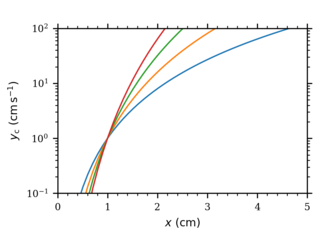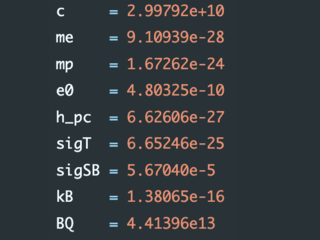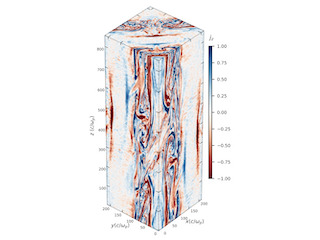Helsinki cluster access
This is a short tutorial to help setup a computing account at the University of Helsinki’s computing cluster. The guide is only relevant for UH students and staff.
As a very first step, you need to ask your group leader to add you to the cluster user group. After that is done, you can follow these steps to log in and install runko.
Preliminary steps
First, you need to login to turso cluster at least once to initialize your home directory structure:
ssh -YA username@turso.cs.helsinki.fi
where username needs to be replaced by your uni-account name. The password is your standard university selected one. The connection only works within the university’s eduroam internet network, i.e., you have to be physically at the campus. If you are greeted with the turso terminal, you can continue to the next step.
If you want to connect from outside the university you need to first jump through via e.g., melkinpaasi.cs.helsinki.fi. Tips for how to automate this are given below.
SSH connection
SSH keys for easier login
Next, you need to identify your machine and update the SSH public keys on the gateway hosts. This step needs to be done only once per machine that you will use to login (or jump to other machines).
First, generate a public SSH key (if you dont already have one). On your own machine’s home directory (i.e., ~/) with
mkdir .ssh
ssh-keygen -t rsa
and press enter for the default suggested directory and for passphrase (i.e. it leave empty).
The command generates
.ssh/id_rsaprivate ssh key.ssh/id_rsa.pubpublic ssh key (for sharing)
In order to whitelist your computer you need to copy the id_rsa.pub key to the host machine’s SSH config and update the ssh agent. In practice,
ssh-add
ssh-copy-id USER@melkinpaasi.cs.helsinki.fi
ssh-copy-id USER@turso.cs.helsinki.fi
SSH shortcut to your .ssh/config
One final touch is to configure your own SSH connections to include hile as a known host. The following step need to be done only once per machine that you will use to login to hile.
Append to your own machine’s ~/.ssh/config (or create the directory and file if it does not exist)
Host turso
HostName turso.cs.helsinki.fi
User username
IdentityFile ~/.ssh/id_ed25519
ProxyJump username@melkinpaasi.cs.helsinki.fi
Host hile
HostName hile01.it.helsinki.fi
User username
IdentityFile ~/.ssh/id_rsa
ProxyJump username@melkki.cs.helsinki.fi
and replace username with the university account name (note that it appears in 4 places here). Note that the whitespace on the command is made via tabs (not spaces).
After this, you should be able to connect to hile from your own machine with
ssh hile
Runko installation
First we need to clone the runko repository to your local hile storage space. All simulation files that need to be accessed by the compute nodes have to reside in the vakka disk space. Therefore, we will also install all of your scripts there.
First, move to the vakka work disk space, and clone the runko repository:
cd /wrk-vakka/users/$USER
git clone --recursive git@github.com:hel-astro-lab/runko.git
Modules
Next, we will automate the loading of the necessary HPC modules on hile. runko repository provides a ready-made module setup file that we can link to the home directory.
ln -s /wrk-vakka/users/$USER/runko/archs/modules ~/modules
After this, we can load the required modules with
module use ~/modules
module --ignore_cache avail
module load runko
The module also sets all the necessary compiler and python directories needed by the code.
Virtual Python environment
Next, we need to initialize our own python virtual environment. You need to have the correct modules (defined above) loaded.
First, we need to create a directory for storing the virtual python packages with
cd /wrk-vakka/users/$USER
mkdir venvs
cd venvs
python3 -m venv runko-cray
Then, activate the environment with
source runko-cray/bin/activate
after which you should see the terminal status bar change to
(runko-cray) username@hile:~$
Note that the runko module file activates the python environments automatically the next time you load it.
Then, we can install the python requirements (stored and reloaded automatically when we login and activate the venv) with
MPICC="cc -shared" pip3 install --no-cache-dir --no-binary=mpi4py mpi4py
pip3 install h5py scipy matplotlib numpy
The mpi4py needs to be installed separately because the mpi from cray-python is configured incorrectly (its modules are compiled with GCC, not CC).
The computing environment is now ready for compilation and regular use. It can be loaded at every login by issuing module load runko.
Runko installation
Next we can compile runko using our new modules. First, move to the vakka work disk space
cd $RUNKODIR
It is also recommended to modify the runko/CMakeLists.txt and activate hile specific compiler flags by adding (around line 30):
set(CMAKE_CXX_FLAGS_RELEASE "-Ofast -flto -ffp=4 -march=znver3 -mtune=znver3 -fopenmp -fsave-loopmark")
Runko installation is now possible. We can compile the code with
mkdir build
cd build
CC=cc CXX=CC cmake -DPython_EXECUTABLE=$(which python3) -DCMAKE_BUILD_TYPE=Release ..
make -j4
After which you should see the compilation take place and the tests being run. Note that the CMake will not find the correct Cray compilers if they are not provided via the prefix CC=c-compiler CXX=c++-compiler before the cmake call.
Runko and SLURM usage
Submitting an example job
The code can be ran by e.g., submitting an example SLURM job in the shock project directory
cd $RUNKODIR
cd projects/pic-shocks
cd jobs
and submitting the example job
sbatch 1dsig3.hile
with the content of 1dsig3.hile being something like
#!/bin/bash
#SBATCH -J 1ds3
#SBATCH -C c
#SBATCH --output=%J.out
#SBATCH --error=%J.err
#SBATCH -c 1 # cores per task
#SBATCH --ntasks-per-node=32 # 128 for amd epyc romes
#SBATCH -t 00-03:00:00 # max run time
#SBATCH --nodes=1 # nodes reserved
#SBATCH --mem-per-cpu=7G # max 7G/128 cores
#SBATCH --distribution=block:block
# SBATCH --exclude= # exclude some nodes
# SBATCH --nodelist= # white list some nodes
module load libfabric
# HILE-C node list
# x3000c0s14b1n0,x3000c0s14b2n0,x3000c0s14b3n0,x3000c0s14b4n0,x3000c0s16b1n0,x3000c0s16b2n0,x3000c0s16b3n0,x3000c0s16b4n0,x3000c0s18b1n0,x3000c0s18b2n0,x3000c0s18b3n0,x3000c0s18b4n0
# specific environment variable settings
export OMP_NUM_THREADS=1
export PYTHONDONTWRITEBYTECODE=true
export HDF5_USE_FILE_LOCKING=FALSE
# Cray optimizations
export MPICH_OFI_STARTUP_CONNECT=1 # create mpi rank connections in the beginning, not on the fly
export FI_CXI_DEFAULT_TX_SIZE=16384 # 4096 # increase max MPI msgs per rank
# export FI_CXI_RDZV_THRESHOLD=16384 # same but for slingshot <2.1
export FI_CXI_RX_MATCH_MODE=hybrid # in case hardware storate overflows, we use software mem
# export FI_OFI_RXM_SAR_LIMIT=524288 # mpi small/eager msg limit in bytes
# export FI_OFI_RXM_BUFFER_SIZE=131072 # mpi msg buffer of 128KiB
# go to working directory
cd $RUNKODIR/projects/pic-shocks/
srun --mpi=cray_shasta python3 pic.py --conf 1dsig3.ini # Cray
This uses hile to run a job in the cpu queue (-C c) on one node (--nodes=1) with 32 cores (--ntasks-per-node=32).
Note that the job script needs to include the module load libfabric which replaces the libfabric module with the newer version located at the compute node.
Basic SLURM commands
You can check the status of the SLURM queue with
squeue
and status of your own jobs with
sacct
Sometimes you might also need information about the available partitions which can be accessed with
sinfo -M all



